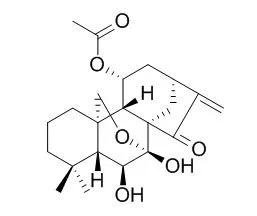Pancreatic cancer is a devastating disease with a poor prognosis. It ranks as the fourth or fifth most common cancer in men and women and has the lowest 5-year survival rate. Therefore, there is an urgent need to develop novel therapeutic agents for pancreatic cancer. Longikaurin E (LE), which is derived from the traditional herbal medicine Rabdosia longituba, had been reported to have anti-proliferative and pro-apoptotic properties in several types of cancers.
METHODS AND RESULTS:
In this study, we investigated the cytotoxic properties of LE against pancreatic cancer cells and explored the mechanism behind the observed apoptosis. Pancreatic cancer cell lines cultured in the presence of LE exhibited dose- and time-dependent growth suppression by clone formation, methylthiazoltetrazolium assay, lactate dehydrogenase cytotoxicity assay, and fluorescence-activated cell sorting analysis, respectively. In addition, these culture conditions also induced the generation of cellular reactive oxygen species (ROS). In order to determine the mechanisms underlying LE-induced cytotoxicity, we used reverse transcription polymerase chain reaction and Western blot analysis in the pancreatic cancer cell line PANC1. The results showed that the expression of Bax was noticeably upregulated and the expression levels of Bcl-2, Bcl-XL, survivin, and c-Myc were significantly downregulated. We also observed increased p38 phosphorylation and decreased phosphorylation of the PI3K/AKT pathway. Interestingly, we also found that LE activated caspase-3. However, N-acetyl-L-cysteine, a kind of antioxidant, reversed all of these cellular activities.
CONCLUSIONS:
In conclusion, this study suggested that LE induced apoptosis of pancreatic cancer cells via ROS generation to modulate the p38 and PI3K/AKT pathways and could be a promising anti-pancreatic agent. |






 Cell. 2018 Jan 11;172(1-2):249-261.e12. doi: 10.1016/j.cell.2017.12.019.IF=36.216(2019)
Cell. 2018 Jan 11;172(1-2):249-261.e12. doi: 10.1016/j.cell.2017.12.019.IF=36.216(2019) Cell Metab. 2020 Mar 3;31(3):534-548.e5. doi: 10.1016/j.cmet.2020.01.002.IF=22.415(2019)
Cell Metab. 2020 Mar 3;31(3):534-548.e5. doi: 10.1016/j.cmet.2020.01.002.IF=22.415(2019) Mol Cell. 2017 Nov 16;68(4):673-685.e6. doi: 10.1016/j.molcel.2017.10.022.IF=14.548(2019)
Mol Cell. 2017 Nov 16;68(4):673-685.e6. doi: 10.1016/j.molcel.2017.10.022.IF=14.548(2019)